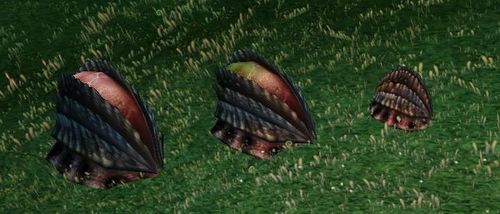|
|
| Line 1: |
Line 1: |
| − | <!-- ••••• OBSOLETE REDACTION >>> The Cokamool is a [[Prime Roots]] [[Flora of Atys|Flora]]. Though technically it's not a plant but a mollusk. It's scientific name is '''Cocoa'''. It appears in 3 variants, seen on the right.In most of the Prime Roots, the Cocoa you'll encounter will be nothing but scenery. But in the [[Kitins' Lair]] some of them can be targeted and killed. Killing these is part of the [[Medic]] and [[Scrollmaker]] [[occupations]].
| |
| − | *'''Cokamool Frez''' appear in the [[Kitins' Lair#Entry Room|entry room]]. They are needed at grade 1 and grade 6.
| |
| − | *'''Cokamool Kloro''' appear in the [[Kitins' Lair#Cattle Room|Cattle Room]]. They are needed at grade 2 and grade 3.
| |
| − | *'''Cokamool Tiny''' appear in the [[Kitins' Lair#Prime Eggs Room|Prime Eggs Room]]. They are needed at grade 4 and grade 5.
| |
| − | The 3 variants can be seen from left to right in the image on the right.
| |
| − | '''An Excerpt from the "Incomplete Atysian botanical atlas" by Komi the Nameless'''
| |
| − | Notwithstanding the fact that some scholars of the past such as Lirni Gillo and Lenardi Bravinchi have insisted upon including Cokamool into the family of plants, It is widely considered to be a shell-encased mollusk. This carnivorous mollusk attaches itself quite firmly to the ground. It has a sticky coloured “tongue” (pinkish red on males and green on females) between its solid horn jaws, that are used to trap insects and other small creatures. Once trapped the prey gets digestd, supplying additional sap to the mollusk. It is advisable not to place ones fingers onto the protruding “tongue”, due to the risk of being unexpectedly seized at the wrist whereupon the mollusk, refusing to let go would force a homin to respawn, succumbing to a coma brought on by thirst and starvation.
| |
| − | The Cokamool mollusks have 2 sexes - the reproduction cycle starts when the males issue Zoods – minuscule proto-organisms capable of travelling large distances, slivering in the moist soil. When the zoods reach a Cokamool female and fertilize its ovum a new Mollusc is conceived.
| |
| − | This creature has been first described by Lirni Gillo who erroneously labelled it a plant and insisted on it’s ability to draw sap from the soil. ••••• -->
| |
| | {{Trad | | {{Trad |
| | |DE=Cokamool | | |DE=Cokamool |
| Line 25: |
Line 16: |
| | |damage=n.a. | | |damage=n.a. |
| | |}} | | |}} |
| − | Actually, the '''cokamool''' (also know as '''cocoa''' is not a plant but a community of animals. | + | Actually, the '''cokamool''' (also know as '''cocoa''' in the [[Kitin's Lair]] of [[Almati Wood]]) is not a plant but a community of animals. |
| | | | |
| | Each tiny hermaphroditic animal grows, with a spongy foot bound to the ground, a very hard shell of the same type as those of the shellfish of the [[Lakes]], with the same protective function. The central part is soft and slimy and serves as mouth, stomach and reproductive organ. As individuals grow, they merge to give the appearance of a single creature. | | Each tiny hermaphroditic animal grows, with a spongy foot bound to the ground, a very hard shell of the same type as those of the shellfish of the [[Lakes]], with the same protective function. The central part is soft and slimy and serves as mouth, stomach and reproductive organ. As individuals grow, they merge to give the appearance of a single creature. |
Revision as of 15:11, 5 August 2019
Translation to review
Don't blame the contributors, but come and help them 😎
Reference text ( Maintained text, used as reference ) :
Notes: (Lanstiril, 2019-08-05)
| Taxonomic Amber
|
| Cokamool
|

|
| Kingdom
|
{{{king}}}
|
| Category
|
{{{species}}}
|
| Main Ecosystem(s)
|
Prime Roots
|
| Counterattack type
|
n.a.
|
Actually, the cokamool (also know as cocoa in the Kitin's Lair of Almati Wood) is not a plant but a community of animals.
Each tiny hermaphroditic animal grows, with a spongy foot bound to the ground, a very hard shell of the same type as those of the shellfish of the Lakes, with the same protective function. The central part is soft and slimy and serves as mouth, stomach and reproductive organ. As individuals grow, they merge to give the appearance of a single creature.
The development of the magnifying lenses by the Trykers allowed its observation. It filters out small organisms (animal and vegetable) that flutter around at the whim of the hot and humid winds of the Prime Roots. At maturity, tiny fragments detach themselves from the soft part and rise in the air to colonize another area.
Like many endemic organisms in the Prime Roots it is bioluminescent.
It is virtually impossible to open a shut cokamool and homins know that you should not risk your fingers under penalty of mutilation.

Cokamools at various stages of development
Last version 2019-11-11•
ᐒ




